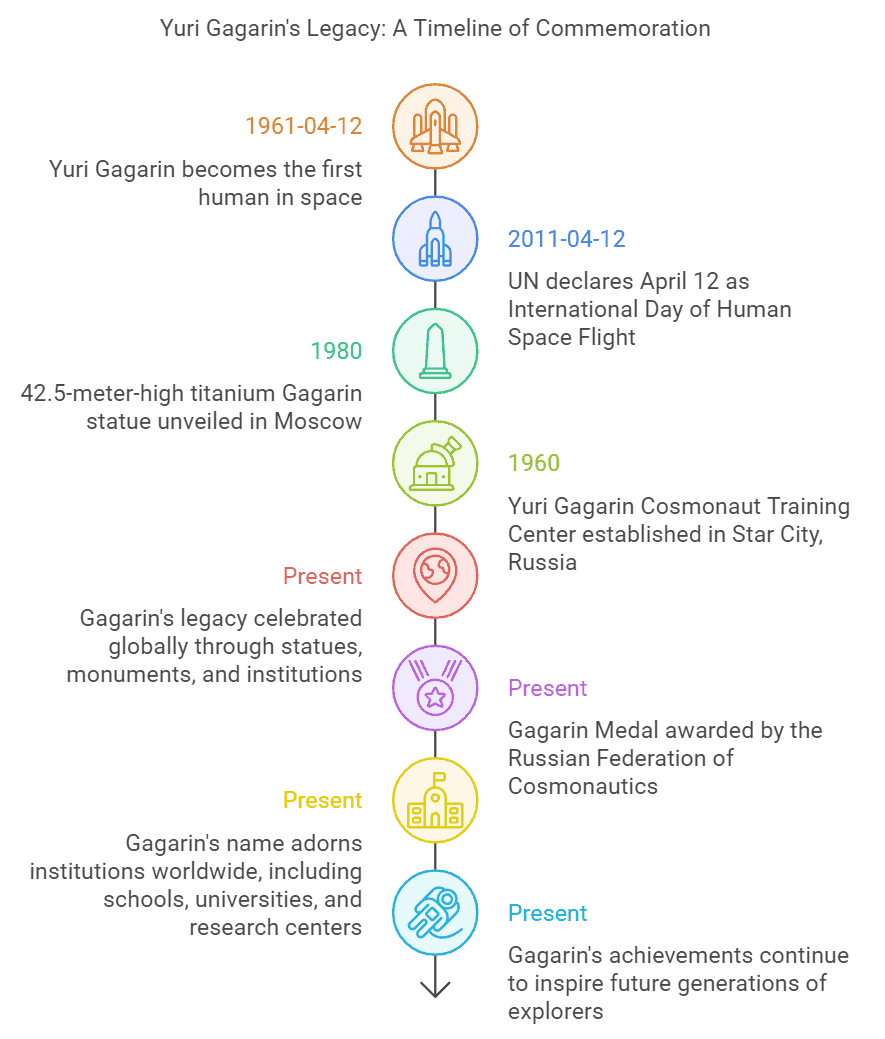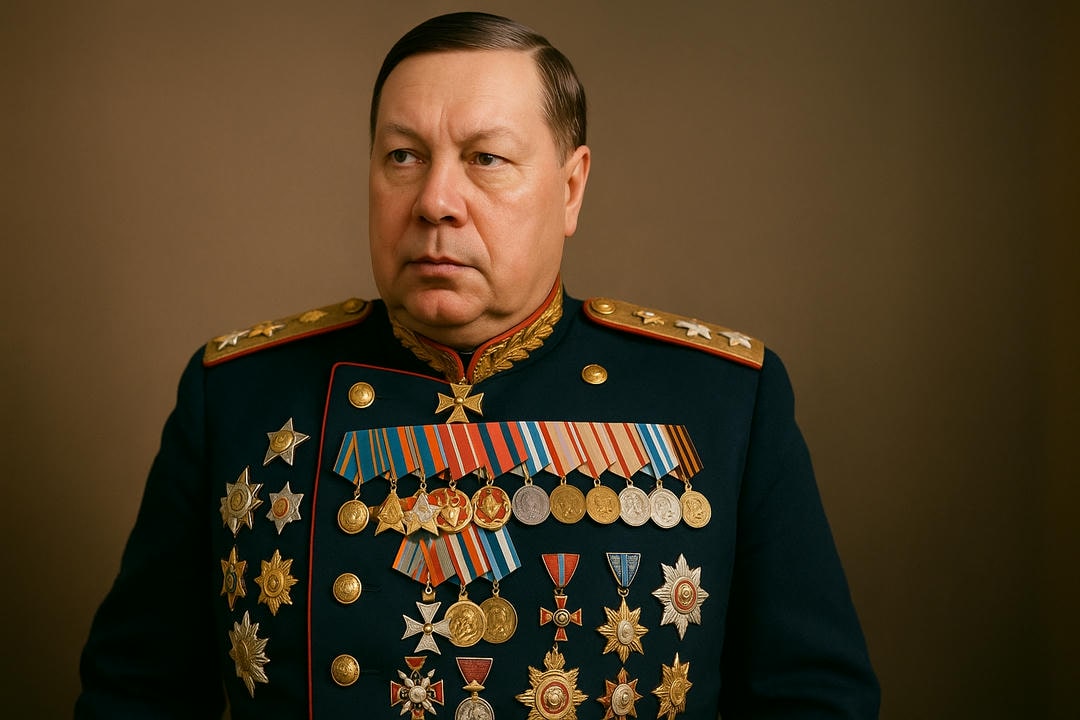Yuri Gagarin’s pioneering voyage on April 12, 1961, marked a monumental leap for humanity, as he became the first person to journey into outer space aboard Vostok 1. This 108-minute orbit not only demonstrated the Soviet Union’s technological capabilities but also ignited a global passion for space exploration. Gagarin’s magnetic personality and heroic status transcended Cold War tensions, making him an enduring symbol of human achievement. By examining the multifaceted impact of Gagarin’s mission, one can appreciate his lasting influence on both international space endeavors and cultural unity.

First Human in Space
Although the world had been captivated by the notion of space travel for decades, it was not until April 12, 1961, that humanity finally breached the bounds of Earth’s atmosphere. Yuri Gagarin’s pioneering journey marked a monumental achievement in human history, catapulting him to instant global recognition.
Aboard the Vostok 1 spacecraft, Gagarin completed a single orbit around Earth in a flight that lasted 108 minutes, showcasing the Soviet Union’s technological advancements. Gagarin’s successful launch and return demonstrated that humans could survive and operate in the harsh environment of space, thereby paving the way for future manned missions.
This milestone was a proof of years of rigorous research, meticulous planning, and the relentless pursuit of technological advancement. In an era marked by Cold War tensions, Gagarin’s feat transcended geopolitical divides, igniting a collective sense of wonder and ambition across the globe.
His journey was not merely a scientific triumph; it was a profound moment of unity for humanity, illustrating the boundless potential for exploration and discovery.
Gagarin’s legacy endures, inspiring generations to look beyond our terrestrial confines and reach for the stars.

He orbited Earth aboard the Vostok 1 spacecraft
Yuri Gagarin’s journey aboard Vostok 1 on April 12, 1961, marked a historic milestone as the first manned orbital flight. Launched from the Baikonur Cosmodrome, Vostok 1 demonstrated Soviet engineering prowess during the Cold War. The spacecraft was meticulously designed to withstand the rigors of space travel, featuring life-support systems that ensured Gagarin’s safety in the harsh environment.
The mission involved a single orbit around Earth, carefully planned to test human endurance and spacecraft reliability. Vostok 1 achieved a maximum altitude of 327 kilometers (203 miles) and traveled at speeds up to 27,400 kilometers per hour. The flight lasted precisely 108 minutes, yielding critical data on microgravity’s effects on the human body. Gagarin’s composed demeanor under pressure showcased the rigorous training of Soviet cosmonauts.
This pioneering mission not only represented a significant technological achievement but also symbolized an ideological victory for the Soviet Union in the space race. Gagarin’s successful orbit laid the groundwork for future manned missions and established him as a global icon in space exploration.
Achieving an altitude of 327 kilometers pushed the boundaries of human experience beyond the Kármán line, the internationally recognized boundary of space at 100 kilometers above sea level. This accomplishment validated complex engineering feats necessary to sustain human life in space and provided invaluable data on microgravity’s impact on the human body.
The spacecraft’s systems, including life support, communications, and re-entry mechanisms, were tested under real operational conditions. Detailed telemetry and observations from this flight offered critical insights that would shape subsequent missions. The altitude reached was not merely a physical measurement; it reflected human ambition and scientific progress, laying the groundwork for deeper exploration into the cosmos.
Vostok 1’s ascent to 327 kilometers underscored a pivotal moment in human space exploration, reinforcing its feasibility and setting a precedent for future endeavors.
Global Celebrity
Following his historic flight, Yuri Gagarin became an international icon, celebrated for both his pioneering achievement and remarkable charisma. His global tour, which included visits to numerous countries, functioned as a diplomatic mission and a promotional campaign for the Soviet space program. Gagarin’s widespread popularity highlighted the profound impact of human space travel on global culture and international relations.
Gagarin’s journey into space not only marked a scientific milestone but also catapulted him into the international limelight. This unprecedented feat resonated globally, transforming him into an emblem of human potential and technological prowess. The immediate embrace of Gagarin by diverse cultures underscored the universal appeal of his accomplishment, symbolizing a collective leap forward in humanity’s quest to explore the cosmos.
The geopolitical context of the Cold War further amplified Gagarin’s fame. As the embodiment of Soviet space superiority, his achievement enhanced the USSR’s global standing. Yet, Gagarin’s appeal transcended political boundaries; his infectious smile and approachable demeanor humanized the technical narratives surrounding his mission, making him relatable across different nations and political systems. His world tour saw him welcomed as a hero in countries such as the United Kingdom, Egypt, and Brazil, fostering international goodwill and illustrating humanity’s fascination with exploration.
The acclaim Gagarin received post-flight was deeply tied to his innate charisma. His engaging personality resonated with people worldwide, transcending political and cultural barriers. Gagarin’s ability to connect with diverse audiences solidified his status as a global icon during a period marked by intense geopolitical tension between the United States and the Soviet Union. His persona offered a human face to the Soviet space program, previously shrouded in secrecy.
Gagarin’s charm and humility endeared him to millions, making him an effective ambassador for Soviet technological prowess and human ingenuity. His story—from humble beginnings to becoming the first human in space—embodied aspirational narratives of progress and possibility. This narrative combined with his charismatic presence ensured that Gagarin was celebrated not only for his singular achievement but also for his ability to inspire and unite people worldwide.

Hero of the Soviet Union
In recognition of his extraordinary achievement, Yuri Gagarin was awarded the title of Hero of the Soviet Union, the highest honor the nation could confer. This accolade reflected his monumental contributions to space exploration and underscored the immense pride and symbolic value his mission held for the Soviet Union during the Cold War.
Gagarin’s successful orbit of Earth represented a culmination of rigorous training and advanced technological development, embodying the pinnacle of Soviet aspirations. His recognition as a Hero of the Soviet Union celebrated not only an individual who pushed the boundaries of human capability but also reinforced the ideological narrative of Soviet superiority in space exploration. This honor provided a significant morale boost to Soviet citizens, fostering unity and national pride. Gagarin’s legacy, enshrined by this prestigious title, endures as a symbol of human endeavor and Soviet ingenuity.
Beyond the title of Hero of the Soviet Union, Gagarin received numerous accolades for his contributions to space exploration. His groundbreaking flight solidified his status as a Soviet hero and earned him international acclaim. Among his honors, Gagarin received the prestigious Order of Lenin, highlighting his bravery and the profound impact of his mission on scientific advancement.
Internationally, Gagarin was celebrated with awards from various countries, including France’s Légion d’Honneur and Liberia’s Order of the African Star. These recognitions reflect his global influence and the universal admiration for his accomplishments. Gagarin also received honorary titles and memberships in scientific institutions worldwide, signifying deep respect for his role in advancing human knowledge.
Collectively, these awards underscore Gagarin’s status as a global icon and trailblazer in space exploration, marking him as a pivotal figure in history.
Influence on Space Exploration
Yuri Gagarin’s successful orbit of Earth in 1961 had profound ramifications on the trajectory of space exploration, catalyzing significant advancements within the space race.
His landmark achievement not only showcased the technological prowess of the Soviet Union but also galvanized the United States to expedite its own space program, culminating in the Apollo Moon missions.
These developments underscored the competitive yet transformative nature of Cold War-era space endeavors, ultimately expanding humanity’s reach into the cosmos.
His successful mission spurred advancements in the space race
Often regarded as a pivotal moment in the Cold War-era space race, Yuri Gagarin’s successful mission aboard Vostok 1 fundamentally altered the trajectory of space exploration. The Soviet Union’s achievement in sending the first human into space was not merely a demonstration of technological prowess but also an embodiment of geopolitical aspirations. The mission’s success catalyzed a series of advancements in aerospace engineering and scientific research, as nations recognized the strategic importance of space supremacy.
Following Gagarin’s historic flight, the Soviet space program redoubled its efforts, leading to significant technological innovations. These included the development of more advanced spacecraft, improved life support systems, and more precise navigation technologies. The Vostok program’s triumphs established a foundation for subsequent missions, pushing the boundaries of human capability in space.
Moreover, Gagarin’s mission intensified international collaboration in space science. Soviet scientists shared findings that contributed to a broader understanding of human physiology in space, prompting global interest in manned spaceflight. The mission also galvanized public support for space programs worldwide, leading to increased funding and research efforts.
Consequently, Gagarin’s momentous journey not only marked a historical achievement but also spurred unprecedented advancements in space exploration.
Prompted the United States to accelerate its own space program
The historic flight of Yuri Gagarin aboard Vostok 1 served as a catalyst for the United States to rapidly intensify its own space program. Confronted with the undeniable prowess of Soviet engineering and the symbolic victory of placing the first human in space, the United States found itself compelled to respond with renewed vigor. This geopolitical context, characterized by Cold War tensions, underscored the urgency of maintaining technological and ideological supremacy.
As a result, Gagarin’s milestone galvanized American political and scientific communities, leading to considerable increases in funding and resources for NASA.
The direct result was a strategic shift in priorities, epitomized by President John F. Kennedy’s impassioned speech to Congress on May 25, 1961, which set forth the ambitious goal of landing a man on the Moon by the end of the decade. This accelerated timeline necessitated advancements in rocketry, human spaceflight, and inter-agency collaboration.
The Mercury and Gemini programs, already in progress, were considerably bolstered to guarantee the feasibility of future lunar missions. Consequently, Gagarin’s pioneering flight not only marked a triumph for the Soviet Union but also spurred the United States to push the boundaries of space exploration, setting the stage for unprecedented achievements.
Contributed to the eventual Apollo Moon missions
Gagarin’s historic voyage aboard Vostok 1 served as a catalyst that profoundly influenced the trajectory of space exploration, ultimately contributing to the success of the Apollo Moon missions. His unprecedented achievement validated human spaceflight and accentuated the necessity for the United States to elevate its space endeavors. This pivotal moment in 1961 catalyzed the Space Race, compelling the U.S. to develop more ambitious programs.
The American response materialized in President John F. Kennedy’s 1961 declaration to land a man on the Moon before the decade’s end. NASA’s Apollo program became the embodiment of this audacious objective. The technical insights garnered from Gagarin’s mission, such as reentry techniques and life-support systems, were meticulously analyzed by NASA engineers to refine their own methodologies.
Furthermore, the psychological and physiological data on human spaceflight provided invaluable benchmarks for the Apollo astronauts’ training regimes. Gagarin’s flight underscored the critical importance of international prestige in space dominance, driving the U.S. to accelerate technological innovation.
This urgency and competitive spirit, spurred by Gagarin’s pioneering journey, directly influenced the triumph of Apollo 11 in 1969, marking a monumental leap for humankind.
Commemorative Days
April 12 holds significant importance in the domain of space exploration, celebrated as Cosmonautics Day in Russia to honor Yuri Gagarin’s groundbreaking journey.
This date’s global significance was further solidified in 2011 when the United Nations declared it the International Day of Human Space Flight, recognizing Gagarin’s monumental achievement.
These commemorative days serve not only to honor Gagarin’s legacy but also to inspire ongoing advancements in human space exploration.
April 12 is celebrated as Cosmonautics Day in Russia
Every year, on the 12th of April, Russia commemorates Cosmonautics Day, a significant observance honoring Yuri Gagarin’s monumental achievement and the broader strides in space exploration undertaken by the Soviet Union. This day, known in Russian as День Космонавтики, marks the anniversary of Gagarin’s historic 1961 flight aboard Vostok 1, which rendered him the first human to journey into outer space.
Cosmonautics Day serves not only as a tribute to Gagarin but also as an acknowledgment of the pioneering efforts of Soviet scientists, engineers, and cosmonauts who collectively propelled humanity into the space age.
The observance is characterized by a series of events including ceremonial gatherings, educational activities, and public exhibits that detail the legacy of Soviet space missions. Institutions such as the Russian Space Agency (Roscosmos) and various aerospace museums play pivotal roles in these commemorations, fostering a sense of pride and historical awareness among the populace.
The day also provides an opportunity to reflect on the enduring impact of Soviet space achievements on subsequent international space endeavors. By celebrating Cosmonautics Day, Russia underscores its pivotal role in the annals of space exploration and honors the enduring spirit of human curiosity and innovation.
Declared the International Day of Human Space Flight by the United Nations in 2011
In recognition of humanity’s profound leap into the cosmos, the United Nations declared April 12 as the International Day of Human Space Flight in 2011, commemorating the pioneering voyage of Yuri Gagarin. This observance not only honors Gagarin’s monumental achievement but also underscores the collective aspirations and scientific advancements that have since transcended national boundaries.
The establishment of this day reflects a global acknowledgment of space exploration as a unifying endeavor that encapsulates human curiosity, resilience, and the relentless pursuit of knowledge.
The declaration by the UN situates Gagarin’s flight within a broader historical and cultural narrative, emphasizing the pivotal role it played in the Space Race and its lasting impact on international cooperation in space. It serves as a reminder of the collaborative spirit that now drives space missions, from the International Space Station to interplanetary exploration.
Additionally, this commemorative day encourages reflection on the technological strides and scientific discoveries ensuing from human spaceflight, fostering an appreciation of space as an arena for peaceful exploration and shared progress.
Thus, the International Day of Human Space Flight stands as a symbol of the enduring inspiration derived from Gagarin’s journey, motivating future generations to reach for the stars.
Legacy and Memorials
Yuri Gagarin’s enduring legacy is immortalized through an array of statues and monuments worldwide, symbolizing his unparalleled contributions to space exploration.
Institutions like the Yuri Gagarin Cosmonaut Training Center stand as prominent indicators of his influence, fostering new generations of astronauts.
Globally, his pioneering achievements continue to be celebrated, reaffirming his pivotal role in advancing humanity’s reach into space.
Gagarin’s legacy is honored through numerous statues and monuments
From the bustling streets of Moscow to remote towns across the globe, statues and monuments honoring Yuri Gagarin stand as enduring symbols of human achievement and exploration.
These commemorations serve not only as tributes to his historic journey aboard Vostok 1 but also as cultural touchstones reflecting the broader human aspiration to explore the cosmos.
In Moscow, the 42.5-meter-high titanium Gagarin statue, revealed in 1980, remains one of the most prominent landmarks. Its gleaming surface and dynamic posture capture the spirit of progress and the triumph of human ingenuity.
Similarly, the town of Gagarin, his birthplace, features a statue that immortalizes his iconic smile and determined gaze, embodying his role as a national hero.
Internationally, Gagarin’s legacy is equally celebrated. Monuments in places like Star City, Russia, and London, UK, underscore his global impact.
These statues are not merely decorative; they are focal points for educational initiatives, public ceremonies, and space-related cultural events. Each monument, whether grand or modest, encapsulates a narrative of perseverance and the relentless human quest for knowledge.
Through these enduring symbols, Gagarin’s pioneering spirit continues to inspire, reminding us of the limitless possibilities when humanity reaches for the stars.
Institutions named after him, including the Yuri Gagarin Cosmonaut Training Center
Beyond the statues and monuments that commemorate Yuri Gagarin’s monumental achievements, numerous institutions globally bear his name, perpetuating his legacy through education and training.
Foremost among these is the Yuri Gagarin Cosmonaut Training Center, located in Star City, Russia. Established in 1960, this premier facility was renamed in Gagarin’s honor shortly after his historic flight. It serves as the epicenter for cosmonaut training, encompassing rigorous physical, psychological, and technical preparation essential for space missions.
The center’s thorough programs have shaped generations of spacefarers, underscoring Gagarin’s enduring impact on space exploration.
Beyond Russia, Gagarin’s name adorns various educational and research institutions worldwide. For instance, schools, universities, and scientific research centers have been named after him, reflecting his status as a symbol of human aspiration and scientific progress.
These institutions not only honor Gagarin’s accomplishments but also inspire new generations to pursue careers in science, technology, engineering, and mathematics (STEM). They serve as a reflection of his global influence, fostering a spirit of innovation and discovery.
His contributions to space exploration continue to be recognized globally
Commemorating Yuri Gagarin’s monumental achievements, various global initiatives and memorials continue to underscore his profound contributions to space exploration. The International Day of Human Space Flight, celebrated annually on April 12, is a representation of Gagarin’s enduring legacy. This day, recognized by the United Nations, serves as a global reminder of humanity’s first steps into the cosmos and the relentless pursuit of space exploration.
In Russia, Gagarin’s name adorns countless institutions, from the Yuri Gagarin Cosmonaut Training Center to the Gagarin Air Force Academy. These establishments not only honor his memory but also perpetuate his pioneering spirit by training new generations of astronauts and pilots.
Internationally, statues, plaques, and exhibitions dedicated to Gagarin can be found in cities such as London, New York, and Paris, reflecting his universal acclaim.
Moreover, the Gagarin Medal, awarded by the Russian Federation of Cosmonautics, continues to recognize individuals who make significant contributions to space exploration. These accolades, coupled with educational programs and public outreach initiatives, guarantee that Gagarin’s legacy remains a source of inspiration.
His achievements serve as a beacon, illuminating the path for future explorers and fostering global collaboration in the quest to understand our universe.





